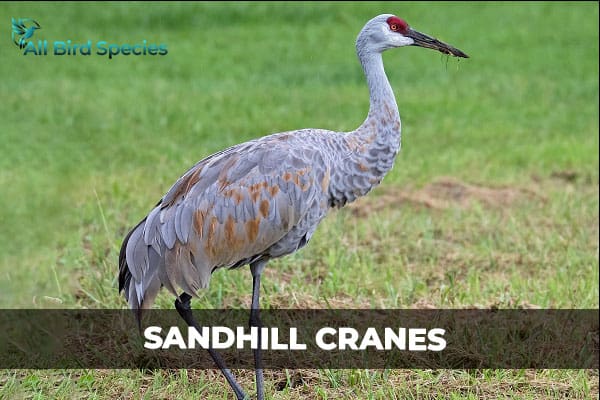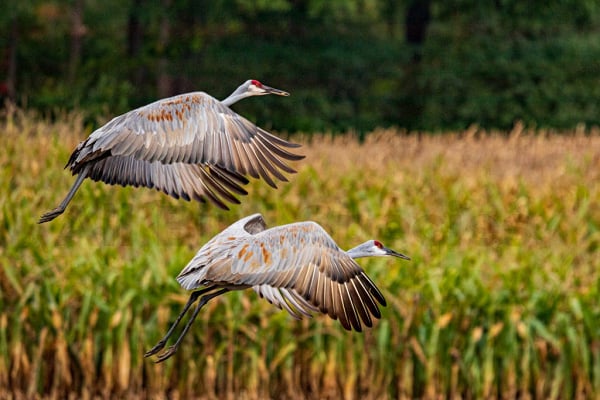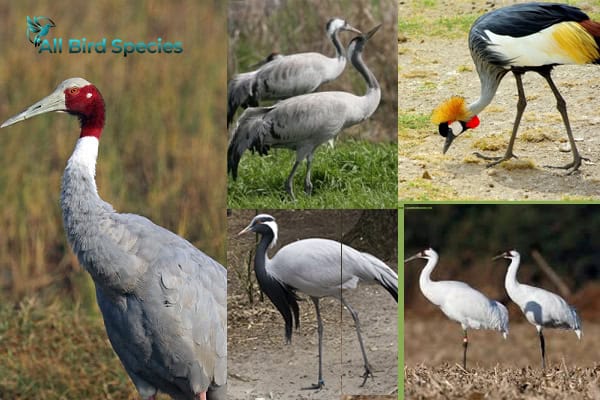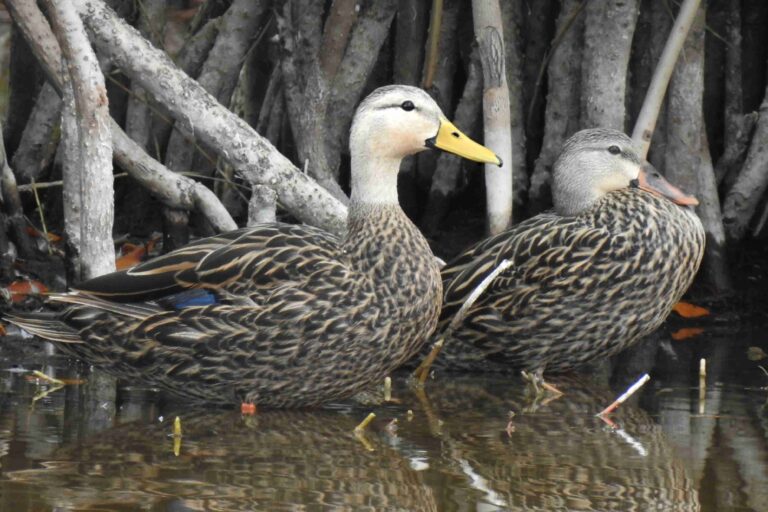15 Types of Cranes: Species, Facts and Pictures
Did you know cranes are among the oldest bird species? They’ve been around for over 10 million years. So today, We’ll look into the amazing types of cranes that make up the Gruidae family.
They have unique traits, and behaviors, and live in various places. We’ll also talk about their diets. This article will share interesting crane facts and beautiful pictures. These show the beauty and importance of these birds in our world.
Let’s start an exciting journey to learn about the 15 crane species on Earth. We’ll see how these magnificent birds play a key role in our ecosystem.
Introduction to the World of Cranes
Cranes capture our imagination with their grace and majesty. This introduction takes us into the amazing world of these large, long-legged birds. They belong to the Gruidae family. Known for their long necks and legs, cranes are well-suited for wading in wetlands, marshes, grasslands, and fields.
Learning about crane behavior and ecology is fascinating for bird lovers and nature enthusiasts. They eat a mix of plants, insects, and small animals. This shows how adaptable they are to their surroundings.
By looking into the world of cranes, we learn about their physical traits and their roles in ecosystems. Each crane species has unique features that spark curiosity and admiration.
The Gruidae Family: An Overview
The Gruidae family is truly fascinating, with 15 crane species known for their beauty and complex social lives. These birds, part of the bird families, have many adaptations that help them survive. They eat a wide variety of foods, like small rodents, fish, and plants, based on what’s available.
Learning about crane classification in the order Gruiformes helps us see how diverse they are. The Gruidae family includes genera like Anthropoides, Balearica, and Grus. Each genus has species with unique traits and places they live, showing how cranes fill different ecological roles.
| Genus | Species | Habitat | Diet |
|---|---|---|---|
| Grus | Common Crane | Wetlands, grasslands | Seeds, grains, insects |
| Grus | Whooping Crane | Marshes, coastal wetlands | Small fish, crustaceans |
| Anthropoides | Demoiselle Crane | Grasslands, steppes | Grains, insects |
| Balearica | Black Crowned Crane | Marshes, grasslands | Seeds, invertebrates |
| Grus | Siberian Crane | Boreal marshes | Roots, tubers |
As we explore cranes further, we’ll see their unique traits and where they live. This will give us a better understanding of the Gruidae family’s diversity.
Types of Cranes Birds
Cranes are fascinating creatures with many types, each unique in their own way. There are 15 species of cranes found around the world. They show a wide range in looks, behavior, and where they live. Let’s explore these crane types and see what makes each one special.
Overview of the 15 Species
The crane family is incredibly diverse. Here’s a quick look at the 15 types:
- Whooping Crane
- Sandhill Crane
- Common Crane
- Red-Crowned Crane
- Grey Crowned Crane
- Black Crowned Crane
- Indian Sarus Crane
- Siberian Crane
- White-Naped Crane
- Demoiselle Crane
- Brolga Crane
- Australian Crane
- Japanese Crane
- East Asian Cranes
- Blue Crane
Each crane species has its own crane species characteristics. For example, the Whooping Crane is tall and has black and white feathers. The Red-Crowned Crane is known for its red head, making it stand out.
What Sets Them Apart?
These cranes are different in looks, behavior, and where they live. For instance:
| Types of Cranes | Habitat | Diet | Conservation Status |
|---|---|---|---|
| Whooping Crane | Wetlands | Insects, small animals | Endangered |
| Sandhill Crane | Grasslands, wetlands | Seeds, grains | Stable |
| Common Crane | Fields, marshes | Insects, plants | Least Concern |
The conservation status of these birds shows the challenges they face. Things like losing their homes and climate change are threats. Knowing about the crane species’ characteristics helps us help them.
Red-Crowned Crane: The Symbol of Luck
The Red-Crowned Crane, also known as the Japanese Crane, is a sight to behold. It lives in the wetlands of East Asia. It’s seen as a symbol of luck and long life, especially in Japan.

This crane can grow up to 5.2 feet tall and weigh between 17 to 22 pounds. Its white feathers and bright red crown make it stand out. Bird lovers all over the world admire it.
The crane’s courtship dance is a key part of finding a mate. These dances show off their strength and symbolize loyalty and love. Watching them, we see the crane’s special qualities up close.
In short, the Red-Crowned Crane, or Japanese Crane, is deeply valued in many cultures. It stands for luck, long life, and love with its beautiful presence.
Sandhill Crane
The Sandhill Crane is a bird known for its strong pair bonds. These bonds often last a lifetime. They live in many places across North America, from lush marshes to wide grasslands and fields.

Habitat and Diet
This crane is about 4 feet tall and has a unique look with a red forehead and dark gray feathers. It lives in different places, giving it lots of food. They eat mostly:
- Seeds
- Insects
- Small mammals
This diet helps them during their long migrations.
Migration Patterns
Every year, Sandhill Cranes make long trips from their breeding grounds in North America and Siberia to their winter homes in the southern U.S. and Mexico. These migrations are crucial for their survival and are a big event for bird lovers and nature fans. They show how adaptable these birds are and why we need to protect their homes.
| Migration Route | Distance (miles) | Wintering Locations |
|---|---|---|
| North America to Southern U.S. | up to 3,000 | Texas, New Mexico |
| Siberia to Southern U.S. | up to 4,000 | California, Arizona |
| Western Canada to Mexico | up to 2,500 | Michoacán, Veracruz |
Whooping Crane
The Whooping Crane is a tall bird, reaching up to 5 feet high. It is known for its white and black feathers. It makes a unique trumpet-like sound, making it stand out. Every year, these birds travel from Canada to Texas, a journey of 2,500 miles.

In winter, they live in the Aransas National Wildlife Refuge. This place is crucial for their survival. We must enjoy watching them while also working to protect them. The Whooping Crane faces big challenges, like losing its home. It’s important to understand their conservation status to help them.
| Characteristic | Details |
|---|---|
| Height | 5 feet |
| Plumage Color | White with black accents |
| Migration Distance | 2,500 miles |
| Breeding Grounds | Wood Buffalo National Park |
| Winter Habitat | Aransas National Wildlife Refuge |
| Conservation Concerns | Habitat loss |
Learning about the Whooping Crane’s challenges in North America makes us appreciate it more. It also motivates us to act to save it for the future.
Common Crane
The Common Crane is a bird that captures our attention with its unique look and interesting ways. It lives mainly in Northern Europe and parts of Asia. It can grow up to 4.3 feet tall and has a wingspan of 7.9 feet. Its gray feathers and red and white head make it stand out among European cranes.

Physical Features and Behavior
These types of cranes are not only beautiful but also have fascinating behaviors. They are known for their dancing behaviors. These dances are important for finding a mate and show how complex their social lives are.
In the winter, they move to warmer places like North Africa and Asia. This shows how adaptable they are. Seeing these birds in the wild helps us learn more about them and their importance in nature.
Siberian Crane
The Siberian Crane is a symbol of nature’s balance with humanity. It has white feathers, a red forecrown, and a sharp beak. But, it faces a big challenge as an endangered species. Only about 3,200 to 4,000 cranes are left.
Loss of habitat and poaching are big threats. Human actions like farming and building cities take away their homes. This makes it hard for the cranes to survive.

Every year, the Siberian Crane travels thousands of miles. They go from northern Russia to places in Iran, India, and China. This journey shows how strong they are as they avoid dangers at high altitudes.
We need to work together to save the Siberian Crane. We should support efforts to fix their homes and make laws to protect them. By spreading the word, we can help people care more about this amazing bird. Let’s work together to save the Siberian Crane for the future.
| Threats Faced | Description |
|---|---|
| Habitat Loss | Destruction of wetlands due to agriculture and urban development. |
| Poaching | Illegal hunting and capture of the crane for food or trade. |
| Climate Change | Alters migratory patterns and breeding grounds. |
| Human Disturbance | Increased activity around nesting areas affects breeding success. |
White-Naped Crane
The White-Naped Crane is a bird that captures the heart with its beau and dance. It can grow up to 4.3 feet tall. Its gray body is highlighted by a white nape, making it stand out. Their dance during courtship is truly impressive.

Diet and Habitat
These types of cranes live in wetlands and grasslands, showing how adaptable it is. It eats grains, seeds, and small aquatic creatures, depending on the season. During breeding, their dance is not just beautiful but also helps strengthen their bonds.
As they move to warmer areas, their social and agile behaviors are clear. This shows how crane habitats are full of life and complexity.
Wrapping on Types Of Cranes Bird Species
Cranes are more than just beautiful birds with different sizes and colors. They are key to the health of our ecosystems. By learning about the various crane species, their behaviors, and where they live, we see how vital they are for biodiversity.
Knowing the challenges cranes face shows us the need to act to save their homes. Exploring their world helps us see how closely cranes are linked to their environments. Through education and getting involved, we can work together to protect these birds and their habitats.
We must stand up for cranes in our world. Supporting conservation efforts and protecting their homes helps our ecosystem. By working together, we can greatly improve the lives of these amazing birds and our planet.







